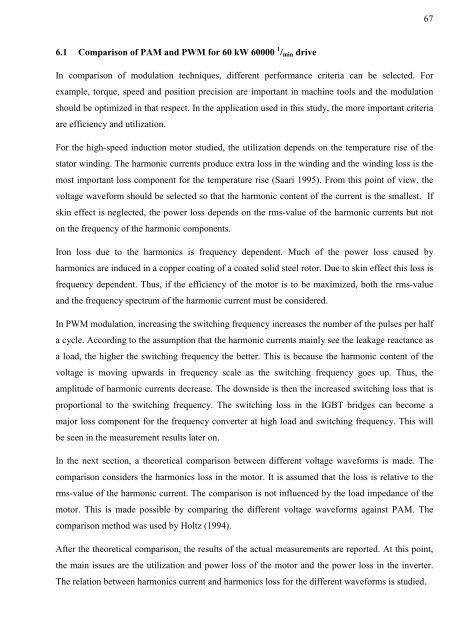Design and Voltage Supply of High-Speed Induction - Aaltodoc
Design and Voltage Supply of High-Speed Induction - Aaltodoc
Design and Voltage Supply of High-Speed Induction - Aaltodoc
Create successful ePaper yourself
Turn your PDF publications into a flip-book with our unique Google optimized e-Paper software.
6.1 Comparison <strong>of</strong> PAM <strong>and</strong> PWM for 60 kW 60000 1 /min drive<br />
In comparison <strong>of</strong> modulation techniques, different performance criteria can be selected. For<br />
example, torque, speed <strong>and</strong> position precision are important in machine tools <strong>and</strong> the modulation<br />
should be optimized in that respect. In the application used in this study, the more important criteria<br />
are efficiency <strong>and</strong> utilization.<br />
For the high-speed induction motor studied, the utilization depends on the temperature rise <strong>of</strong> the<br />
stator winding. The harmonic currents produce extra loss in the winding <strong>and</strong> the winding loss is the<br />
most important loss component for the temperature rise (Saari 1995). From this point <strong>of</strong> view, the<br />
voltage waveform should be selected so that the harmonic content <strong>of</strong> the current is the smallest. If<br />
skin effect is neglected, the power loss depends on the rms-value <strong>of</strong> the harmonic currents but not<br />
on the frequency <strong>of</strong> the harmonic components.<br />
Iron loss due to the harmonics is frequency dependent. Much <strong>of</strong> the power loss caused by<br />
harmonics are induced in a copper coating <strong>of</strong> a coated solid steel rotor. Due to skin effect this loss is<br />
frequency dependent. Thus, if the efficiency <strong>of</strong> the motor is to be maximized, both the rms-value<br />
<strong>and</strong> the frequency spectrum <strong>of</strong> the harmonic current must be considered.<br />
In PWM modulation, increasing the switching frequency increases the number <strong>of</strong> the pulses per half<br />
a cycle. According to the assumption that the harmonic currents mainly see the leakage reactance as<br />
a load, the higher the switching frequency the better. This is because the harmonic content <strong>of</strong> the<br />
voltage is moving upwards in frequency scale as the switching frequency goes up. Thus, the<br />
amplitude <strong>of</strong> harmonic currents decrease. The downside is then the increased switching loss that is<br />
proportional to the switching frequency. The switching loss in the IGBT bridges can become a<br />
major loss component for the frequency converter at high load <strong>and</strong> switching frequency. This will<br />
be seen in the measurement results later on.<br />
In the next section, a theoretical comparison between different voltage waveforms is made. The<br />
comparison considers the harmonics loss in the motor. It is assumed that the loss is relative to the<br />
rms-value <strong>of</strong> the harmonic current. The comparison is not influenced by the load impedance <strong>of</strong> the<br />
motor. This is made possible by comparing the different voltage waveforms against PAM. The<br />
comparison method was used by Holtz (1994).<br />
After the theoretical comparison, the results <strong>of</strong> the actual measurements are reported. At this point,<br />
the main issues are the utilization <strong>and</strong> power loss <strong>of</strong> the motor <strong>and</strong> the power loss in the inverter.<br />
The relation between harmonics current <strong>and</strong> harmonics loss for the different waveforms is studied.<br />
67
















